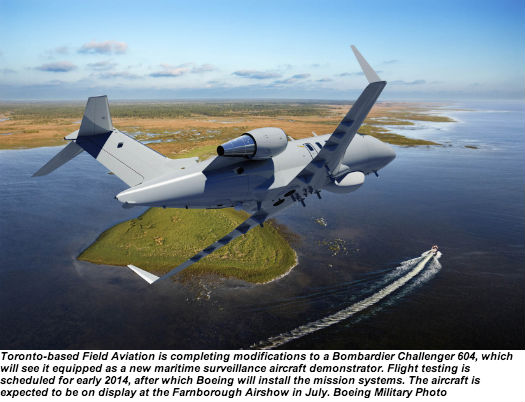Estimated reading time 6 minutes, 31 seconds.
Toronto-based Field Aviation, having bet jointly with Boeing on the Bombardier Challenger 605 as the platform of choice for a new maritime surveillance aircraft (MSA), is preparing to flight test a demonstrator early in 2014.
“The Challenger . . . is an ideal platform to host the MSA’s mission system, sensors and communications equipment,” Tim Peters, Boeing’s vice president and general manager, Mobility, Surveillance & Engagement, confirmed at the Dubai Airshow in November. “It also provides the power, payload capacity, range, speed, and endurance that our customers tell us they need for missions such as anti-piracy; coastal and border security; and long-range search and rescue.”
Brian Love, chief commercial officer at Field Aviation and one of five owners, told Canadian Skies that the company was approached by Boeing in the spring of 2012. The aerospace giant evidently had realized that its own P-8A Poseidon, a 737-800 “next generation” derivative, would be too pricey or even unnecessarily complex for maritime surveillance in some countries, partly because of its sophisticated missions systems.
“So they spent about two years looking at the market and what size of aircraft would fill that band between a P-8 and what we would traditionally have done here at Field as a maritime patrol aircraft, a Dash 8-size of turboprop,” said Love. “They didn’t have a Boeing product that would fit. The concept was to shrink a P-8 mission system, take off some of the weaponization – although those systems are potential add-ons on this platform, but to a much lesser degree than on a P-8 – and put it in a smaller package.”
Preferring a jet with appropriate speed and endurance, Boeing looked at Gulfstream and Falcon as well as Bombardier, eventually settling on the latter. It approached Field because of that company’s successful three-aircraft Challenger 604 MSA program for the Royal Danish Air Force.
But when Boeing asked Field to bid as a potential modifier, Field countered with an offer to share the risk, essentially modifying the demonstrator on its own. “That was pretty exciting for them,” said Love. “Boeing obviously has much deeper pockets that we do; but, as with any program, they have a budget to work with. This helps them meet that.”
Boeing predicts a market for 150 to 200 Challenger 650 MSA aircraft over the first 15 years. “Even if they win only half of that, that’s a steady stream of six to eight aircraft, which would be a nice base for our modification business,” said Love. Field, an $80-million a year operation with 300 employees, also has a parts manufacturing plant in Calgary, Alta. “That’s steady, predictable work,” Love explained, “but the modification business can be cyclical.”
Field is in the process of completing modifications to the demonstrator, a Challenger 604 out of Boeing’s corporate fleet, and will wrap up ground testing before moving to flight testing in the U.S. and Canada. The modifications include structural upgrades as well as all prototype external sensor housings. Once flight testing is finished, Boeing will install the mission systems with a view to having the demonstrator at the Farnborough Airshow in July.
“Boeing’s been very actively selling this in the last 12 months,” added Love. That has included setting up a new sales division specifically for the Challenger project. Love understood that Boeing had been pursuing opportunities in some two dozen countries, and that five or six were “pretty far along,” suggesting that the Farnborough debut could include a launch customer.
Production aircraft will be green 605s, which are effectively the same airframe as the 604s, the 365th and last of which rolled out of Bombardier’s plant in 2006, but with a slightly greater payload capacity. While Field would be doing much of the installation at its Toronto facility, the company’s board was expected to decide in January which of two sites in Ohio it would use for additional work.
A rendering of the aircraft shows it fitted with the P-8A’s Raytheon AN/APY-10 multi-mode radar in a 360-degree belly housing, various antenna under the centre wing section, and a retractable electro-optical turret in the rear fuselage. It also appears to show CAE’s magnetic anomaly detection boom under the tail.
In concept and layout, the aircraft would not be dissimilar from the Challenger 604 multi-mission aircraft modified by Field in the early 2000s, building on an earlier CC-144 maritime patrol variant.
As the Canadian government continues to talk about the need for a strong Arctic presence, there’s no escaping the continuing appeal of an aircraft which would complement the RCAF’s fleet of highly-capable and recently-upgraded Lockheed-Martin CP-140 Aurora turboprop long-range patrol and surveillance aircraft.
Love said that Boeing had been looking for an aircraft with “the right combination of speed, payload and endurance” and that’s what they will be getting with the 605. It can make good time, even from a southern base, and still have significant time on station up north. Cabin size also was a deciding factor in that a civil 605 can carry up to 12 passengers. In addition to a flight crew of two, the MSA variant could accommodate up to five mission personnel in the back, while still affording generous crew rest space.
“There’s no question that the further north you could put it, the better-placed it would be,” Love said. “We certainly see Canada as a pretty important market.”

